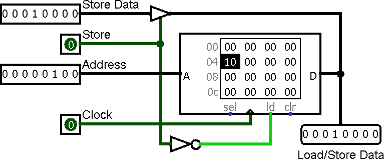- Logisim home page
- Guide to Being a Logisim User
- Library Reference
 RAM
RAM
| Library: | Memory |
| Introduced: | 2.0 Beta 1 |
| Appearance: |  |
Behavior
The RAM component, easily the most complex component in Logisim's built-in libraries, stores up to 16,777,216 values (specified in the Address Bit Width attribute), each of which can include up to to 32 bits (specified in the Data Bit Width attribute). The circuit can load and store values in RAM. Also, the user can modify individual values interactively via the Poke Tool, or the user can modify the entire contents via the Menu Tool.
Current values are displayed in the component. Addresses displayed are listed in gray to the left of the display area. Inside, each value is listed using hexadecimal. The value at the currently selected address will be displayed in inverse text (white on black).
The RAM component supports three different interfaces, depending on the Data Interface attribute.
- One synchronous load/store port (default)
The component includes a single port on its east side that serves for both loading and storing data. Which it performs depends on the input labeled ld: 1 (or floating) indicates to load the data at the address designated on the component's west side, and 0 indicates to store the data given on the port. To transmit data into and out of the component, you will need to use a Controlled Buffer component, as illustrated below.

- One asynchronous load/store port
This is the same as above, except that there is no clock. The value found on the data bus is stored into memory whenever the ld input is 0. If, while the ld input is 0, the address or data changes, then an additional store occurs. This option is meant to more closely approximate the interface of many available random-access memories.
- Separate load and store ports
Two data ports are provided - one on the west side for storing data, and another on the east side for loading data. This option removes the necessity of dealing with the Controlled Buffer and so it is easier to use.
- A on west edge (input, bit width matches Address Bit Width attribute)
- Selects which of the values in memory is currently being accessed by the circuit.
- D on west edge (input, bit width matches Data Bit Width attribute)
- This input is present only if "separate load and store ports" is selected for the Data Port attribute. When a store is requested (via the clock changing from 0 to 1 while sel and str are both 1 or floating), the value found at this port is stored into memory at the currently selected address.
- D on east edge (input/output or output, bit width matches Data Bit Width attribute)
- If sel and ld are 1 or floating, then the RAM component emits the value found at the currently selected address on this port. If there is a single load/store port, the value read from this port is stored whenever a store is requested.
- str on south edge (input, bit width 1)
- Store: This input is present only if "separate load and store ports" is selected for the Data Port attribute. When it is 1 or floating, a clock pulse will result in storing the data found on the west edge into memory (provided the sel input is also 1 or floating).
- sel on south edge (input, bit width 1)
- Select: This input enables or disables the entire RAM module, based on whether the value is 1/floating or 0. The input is meant primarily for situations where you have multiple RAM units, only one of which would be enabled at any time.
- triangle on south edge (input, bit width 1)
- Clock input: This is absent when the Data Port attribute's value is "One asynchronous load/store port." In other circumstances, when ld is 0, and this input rises from 0 to 1 (and sel is 1/undefined and clr is 0), then the value at the currently selected address changes to whatever value is at the D pin. As long as the clock input remains 0 or 1, though, the D value will not be stored into memory.
- ld on south edge (input, bit width 1)
- Load: Selects whether the RAM should emit (on D) the value at the current address (A). This output behavior is enabled if out is 1 or undefined; if out is 0, then no value is pushed onto D - but if there is a combined load/store port, stores will be enabled.
- clr on south edge (input, bit width 1)
- Clear: When this is 1, all values in memory are pinned to 0, no matter what the other inputs are.
- Address Bit Width
- The bit width of the address bits. The number of values stored in RAM is 2addrBitWidth.
- Data Bit Width
- The bit width of each individual value in memory.
- Data Port
- Configures which of the three interfaces are used for communicating data into and out of the component.
Pins
Attributes
Poke Tool Behavior
See poking memory in the User's Guide.
Text Tool Behavior
None.
Menu Tool Behavior
See pop-up menus and files in the User's Guide.